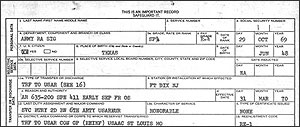Directory
Welcome Veterans and Their Families to the DD214 Website!!
If you'd like to learn everything possible about DD Form 214, commonly referred to as just DD214, you've come to the right place. But, before we get into the minutia, the DD214's history, importance and many uses, most people who visit this site simply want to know the best method to acquire a certified copy of their (or their close relative's) DD214. In order to save you some time, we've placed a link to The Best Method to Acquire Your DD214 (Click HERE) first.
What is a DD214?
 The Defense Department issues to each veteran a DD-214, identifying the veteran's condition of discharge - honorable,
general, other than honorable, dishonorable or bad conduct. You can find a sample DD-214 which can help you determine if a veteran served in armed combat HERE. Before January 1, 1950, several similar forms were used by
the military services, including the WD AGO 53, WD AGO 55, WD AGO 53-55, NAVPERS 553, NAVMC 78PD, and the NAVCG 553.
The Defense Department issues to each veteran a DD-214, identifying the veteran's condition of discharge - honorable,
general, other than honorable, dishonorable or bad conduct. You can find a sample DD-214 which can help you determine if a veteran served in armed combat HERE. Before January 1, 1950, several similar forms were used by
the military services, including the WD AGO 53, WD AGO 55, WD AGO 53-55, NAVPERS 553, NAVMC 78PD, and the NAVCG 553.
Want to know the legal nitty gritty? We've provided the complete DoD Instruction NUMBER 1336.1 concernng Certificate of Release or Discharge from Active Duty (DD Form 214/5 Series) HERE (4.5 mb). We've also provided:
- Air Force Regulation 36-3202 Guidance Memorandum for the Preparatuion of Separation Documents HERE (494 k)
- Army Regulation 635-8 concerning the preparation and distribution of separation documents HERE (449 k)
- the Marine Corps Separation and Retirement Manual, MARCORSEPMAN HERE (1.54 mb)
- the Naval Military Personnel Manual NAVPERS 15560D HERE (19.79 mb)
- and you can access the National Guard's process for their issuance of their discharge certificates (NGB Form 22) HERE (874 k).
Why is a DD214 important?
The Report of Separation contains information normally needed to verify military service for benefits, retirement, employment, and membership in veterans' organizations. Information shown on the Report of Separation may include the service member's:
- Date and place of entry into active duty
- Home address at time of entry
- Date and place of release from active duty
- Home address after separation
- Last duty assignment and rank
- Military job specialty
- Military education
- Decorations, medals, badges, citations, and campaign awards
- Total creditable service
- Foreign service credited
- Separation information (type of separation, character of service, authority and reason for separation, separation and reenlistment eligibility codes)